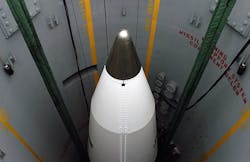Officials of the Missile Defense Agency (MDA) in Huntsville, Ala., announced are asking the Boeing Defense, Space & Security segment team in Huntsville, Ala., to build and deploy a new land-based ballistic missile defense system designed to destroy incoming enemy missiles in space before they re-enter the Earth's atmosphere.
This order is to extend the Ground-based Midcourse Defense (GMD) development and sustainment contract. The GMD provides limited capability to intercept incoming warheads in space during their midcourse phase of ballistic trajectory flight.
Boeing and its team members will build the new anti ballistic missile field near an existing GMD missile field at Fort Greely, Alaska. The new field is at least partially in response to North Korea's accelerated long-range missile testing program. GMD interceptor sites are at Fort Greely, Alaska, and at Vandenberg Air Force Base, on the Central California coast.
Last year the Missile Defense Agency scheduled its first GMD intercept test in three years in response to North Korean ballistic missile threats.
Related: Electro-optical sensors key to missile defense
Boeing is under contract to develop, field, test, integrate and configure, build, refurbish, and sustain the GMD system. This new order asks Boeing also to improve the system with a redesigned kill vehicle, software upgrades, and cyber security.
On the Boeing GMD team are Orbital ATK, Northrop Grumman Corp., and Raytheon Co. The GMD system consists of radar-guided ground-based interceptor missiles to intercept incoming warheads in space. Key subsystems are the Raytheon exoatmospheric kill vehicle; Orbital Sciences ground-based interceptor boost vehicle; Northrop Grumman battle management and communications; and Raytheon ground-based radars.
On this order the Boeing team will do the work in Huntsville, Ala.; Fort Greely, Alaska; Vandenberg Air Force Base, Calif.; Schriever Air Force Base, Peterson Air Force Base, Cheyenne Mountain Air Station, and Colorado Springs, Colo.; Tucson, Ariz; and other U.S. locations, and should be finished by December 2023.
For more information contact Boeing Defense, Space & Security on line at www.boeing.com/defense, or the Missile Defense Agency at www.mda.mil.
Ready to make a purchase? Search the Military & Aerospace Electronics Buyer's Guide for companies, new products, press releases, and videos



